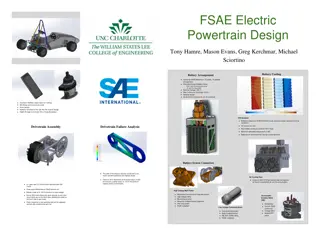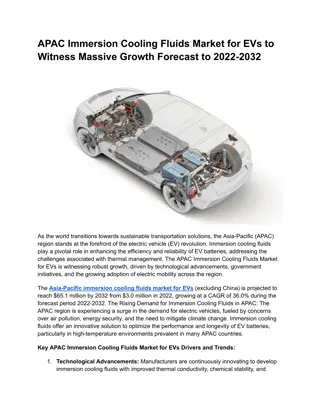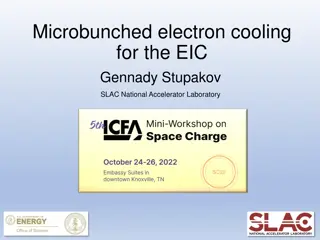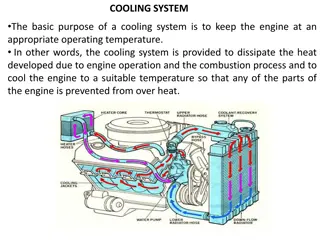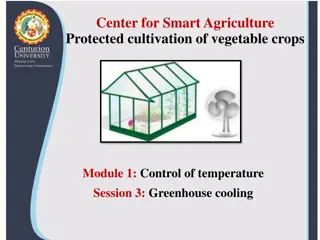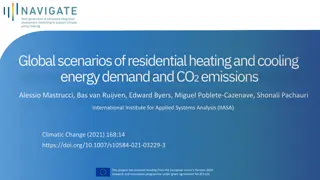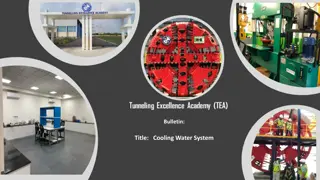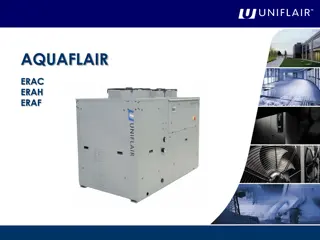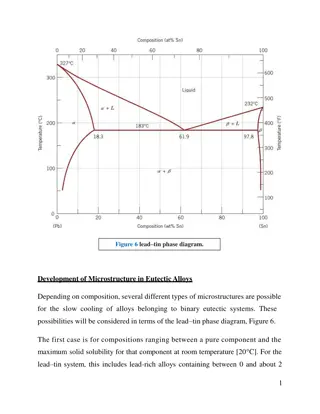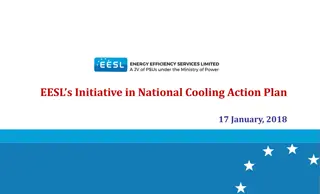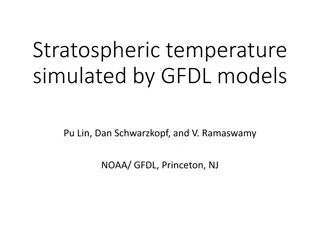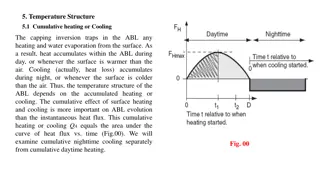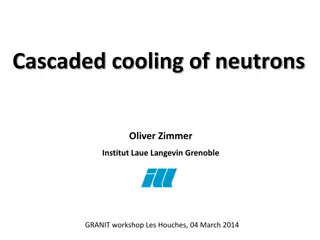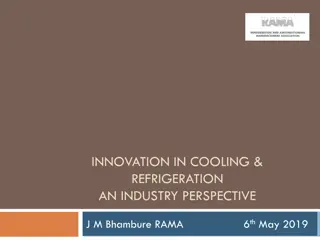
MEIC Electron Cooling Collaboration Meeting Overview
Learn about the multi-step cooling scheme adopted by MEIC for high luminosities in their proton/ion collider. Discover the design concepts, technologies, and strategies utilized for efficient electron cooling, boosting performance and beam quality.
Download Presentation

Please find below an Image/Link to download the presentation.
The content on the website is provided AS IS for your information and personal use only. It may not be sold, licensed, or shared on other websites without obtaining consent from the author. If you encounter any issues during the download, it is possible that the publisher has removed the file from their server.
You are allowed to download the files provided on this website for personal or commercial use, subject to the condition that they are used lawfully. All files are the property of their respective owners.
The content on the website is provided AS IS for your information and personal use only. It may not be sold, licensed, or shared on other websites without obtaining consent from the author.
E N D
Presentation Transcript
MEIC Electron Cooling MEIC Collaboration Meeting Spring 2015 March 30 and 31, 2015
Outline Introduction MEIC Electron Cooling Scheme DC Cooling Bunched Beam Cooler Design Summary 2
Introduction MEIC relies on conventional electron cooling for delivering high luminosities MEIC has adopted a multi-step cooling scheme, utilizes a DC cooler in the booster ring and a high energy cooler with a bunched electron beam in the collider ring A design concept has been developed for a bunched beam electron cooler based an ERL. This cooler is sufficient for the present MEIC baseline An ultimate cooler design include a circulator ring that will help to deliver an 1+ A current cooling electron beam; it supports a luminosity upgrade (exceeding 1034 cm-2s-1) 3
Multi-Step Cooling for High Performance Cooling of the MEIC protons/ions achieves a small emittance achieves a short bunch length of 1 to 2 cm (with strong SRF) enables ultra strong final focusing and crab crossing suppresses intra-beam scatterings (IBS), maintaining beam emittance expands luminosity lifetime MEIC adopts conventional electron cooling Well established technology (in the low energy DC regime) Multi-step scheme taking advantages of high cooling efficiency at low energy or/and with small emittance cool ~ 2 4 z d 4
MEIC Multi-Step Cooling Scheme BB cooler DC cooler ion linac ion sources Booster collider ring (8 to 100 GeV) (0.285 to 8 GeV) Ring Cooler Function Ion energy Electron energy GeV/u MeV Injection/accumulation of positive ions 0.11 ~ 0.19 (injection) 0.062 ~ 0.1 Booster DC Emittance reduction 2 1.1 Maintain emittance during stacking 7.9 4.3 Bunched Beam (BB) (injection) Collider Maintain emittance Up to 100 Up to 55 DC cooling for emittance reduction BB (bunched beam) cooling for emittance preservation We anticipate up to 2 orders of magnitude increase of combined cooling rate 5
MEIC DC Cooler: Within State-of-Art Design specifications Magnetized beam Energy range: Electron current: 2 A Cooling section: 10 m 0.11 to 1.1 MeV We plan to collaborate with Budker Institute to adopt this cooler design for MEIC Present status of technology Well developed and low cost, The most recent experience is a 2 MeV cooler for COSY built by Budker Institute recently successfully commissioned COSY Parameter Energy range High voltage stability Electron current Cooling section length Solenoid field (cooling section) Electron beam diameter Toroid radius Unit MeV Value 0.1 to 2 < 10-4 0.1 to 2 2.69 0.5 to 2 1 ~ 3 1 A m kG cm m COSY, IKP, J lich 6
Bunched Beam Cooler: Baseline & Ultimate For the present baseline, the designed emittance (0.5 to 1 mm mrad) leads to a much longer IBS growth time, thus requiring a significantly lower electron current In an anticipated design optimization (or as an option of future luminosity upgrade), we need a higher electron current Present baseline up to 55 0.2 / 0.42 476 60 2 3 2 586.3 1.5 29.7 Ultimate up to 55 1.5 / 3.15 476 60 2 3 2 586.3 1.5 29.7 Electron energy Beam Current and bunch charge Bunch repetition Cooling section length RMS Bunch length Electron energy spread Cooling section solenoid field Normalized drift emittance Normalized Larmor emittance Normalized transverse emittance MeV A / nC MHz m cm 10-4 T mm mrad mm mrad mm mrad 7
Bunched Beam Cooler Design Concept Utilizes energy-recovery-linac (ERL) (the beam power is up to 11 MW) Cooling by a bunched electron beam Cooling section ion bunch circulations 25+ electron bunch solenoid Kicker rep rate MHz 19.05 Kick duration ns 2.1 Ultra fast kicker Angle mrad Ultra fast kicker energy recovery SRF Linac dump injector 8
The 1st Design Attempt of ERL-Circulator Cooler decompression D. Douglas, C. Tennant Circulator Cooler Ring dump beam exchange system cooling solenoids ERL SRF injector Magnetized source recompression Advanced design elements Magnetized electron beam/source Round-to-flat transform Energy at injection/dump Long. emitt. at injection RMS length @ injection Full energy Acceleration/recovery phase RMS bunch length at CCR MeV keV-ps ps MeV 5/5.3 80 5 54 -13/166 1~3 Accelerator technologies High current electron source Ultra fast kicker cm 10
Preliminary Study of Beam Dynamics In a Circulator Ring Particle tracking (Elegant) simulations of an electron bunch in the circulator cooler ring 0.5 -- 2 nC bunch charge (2 nC design value) 1 -- 3 cm bunch length (3 cm design value) < 0.1% energy spread (5x10-4 design value) 1 cm 2 nC, After 10 turns 2 cm Factors limiting number of circulations in CCR Beam quality degradation by intra/inter beam scatterings Space charge Micro-bunching instabilities 3 cm Coherent synchrotron radiation (CSR) could induce micro-bunching instabilities, 0.5 nC, 3 cm. 100 turns CSR mitigation Magnetized beam (Ya. Derbenev) (it also suppresses space charge effect) Shielding in beam pipe Optical management (D. Douglas) (Using longitudinal periodic achromat, simulations show little to no micro-bunching ) p/p~10-4 p/p~9x10-4 E. Nissen, C. Tennant 11
Proposed Experimental Demonstration of Cooling with a Bunched Electron Beam A collaboration of JLab, IMP (China) and BINP (Russia) currently under discussion Cooling by a bunched electron beam is considered one (remaining) critical R&D for the MEIC present baseline IMP has two storage rings, each has a DC cooler for ion coasting beams (built in collaboration with BINP, Russia) A pilot study supported by a JLab LDRD in progress A. Hutton (JLab) H. Zhao (IMP) Institute of Modern Physics (IMP), Chinese Academy of Science (CAS) BNL LeReC program also utilizes a BB e-cooler DC cooler 12 Slide 12
RF kicker Like an RF separator, a strip-line kicker driven by a waveform which is a superposition of multi harmonic waveforms Requires a multi-harmonic signal amplifier RF kicker A. Kimber 1.5 Beam-beam kicker 1 0.5 F 0 -10 -5 0 5 10 surface charge density v c -0.5 -1 h D kicking beam c v0 L V. Shiltsev, NIM 1996
LDRD and SBIR for Cooler R&D For the present MEIC baseline design Experiential demo of cooling of ions by a bunched electron beam (LDRD) Cooling simulations (SBIR) Cooling software development (LDRD) For achieving luminosity above 1034 cm-2s-1 Improvement of cooling simulation (including code development LDRD) Development of an RF based fast kicker (LDRD) Development of high bunch charge/current magnetized electron source (SBIR and pending LDRD) Demonstration of mitigation of coherent synchrotron radiation/micro- bunching instability (LDRD) 15
Circulator Ring for Higher Current/Luminosity To reach luminosities beyond the present baseline (>1034 cm-2s-1) Requires much smaller emittance (0.35 and 0.07 mm mrad) Requires much higher electron current for cooling, ~1.5 A (bunch charge 3.15 nC) A circulator ring will reuse the bunches 25 times, thus, reduce the current from the electron source/injector by a same factor Beyond state-of-the-art Require a ultra-fast kicker to switch the bunches in and out of the cooler ring Require a high bunch charge (~3.15 nC) electron source/injector Must suppress the collective instabilities Bunch revolutions in CCR Current in CCR/ERL Electrons/bunch Bunch repetition rate in CCR/ERL ~25 ion bunch A 1.5/0.06 electron bunch Cooling section solenoid 1010 MHz 1.25 476/30 circulator ring Fast kicker Fast kicker energy recovery injector recirculating 25+ turns reduction of current from an ERL by a same factor dump SRF Linac 18
Proposed Beam Studies and Technology Development for an ERL-Circulator Cooler Dechirper Rechirper Cooler Test Facility @ JLab FEL ERL New Beam-line Demonstrate the cooler design concept Develop/test key technologies (magnetized gun, fast kickers, etc.) Study dynamics of the cooling bunches in a circulator ring Using the existing ERL without upgrade, adding two 180 dipoles (available at JLab) Supporting MEIC to deliver the high luminosity (1034 1/cm2/s), 19
We propose a three-gun injector, based on the CEBAF injector success Beam current: 3 x 67 ~ 200 mA (Cornell, 60 mA) Bunch charge: 0.42 nC, very comfortable for a DC/RF photo-cathode gun All existing/demonstrated technologies Steering (BPMs/kickers) Beams from three individual guns Gun Solenoids (emittance compensation) One beam RF recombiner dipole buncher collimation CEBAF injector Master slit dipole A Chopper cavity Chopper cavity Polarized DC gun Master slit B C One beam Three beam One beam 20



